| Article ID | Journal | Published Year | Pages | File Type |
|---|---|---|---|---|
| 4454304 | Journal of Environmental Sciences | 2014 | 11 Pages |
Photocatalytic ozonation of phenol and oxalic acid (OA) was conducted with a Ag+/TiO2 catalyst and different pathways were found for the degradation of different compounds. Ag+ greatly promoted the photocatalytic degradation of contaminants due to its role as an electron scavenger. It also accelerated the removal rate of OA in ozonation and the simultaneous process for its complex reaction with oxalate. Phenol could be degraded both in direct ozonation and photolysis, but the TOC removal rates were much higher in the simultaneous processes due to the oxidation of hydroxyl radicals resulting from synergetic effects. The sequence of photo-illumination and ozone exposure in the combined process showed quite different effects in phenol degradation and TOC removal. The synergetic effects in different combined processes were found to be highly related to the properties of the target pollutants. The color change of the solution and TEM result confirmed that Ag+ was easily reduced and deposited on the surface of TiO2 under photo-illumination, and dissolved again into solution in the presence of ozone. This simple cycle of enrichment and distribution of Ag+ can greatly benefit the design of advanced oxidation processes, in which the sequences of ozone and photo-illumination can be varied according to the needs for catalyst recycling and the different properties of pollutants.
